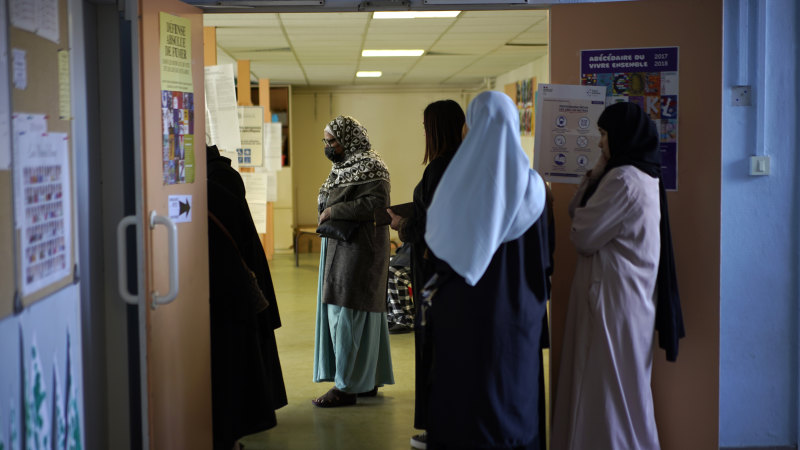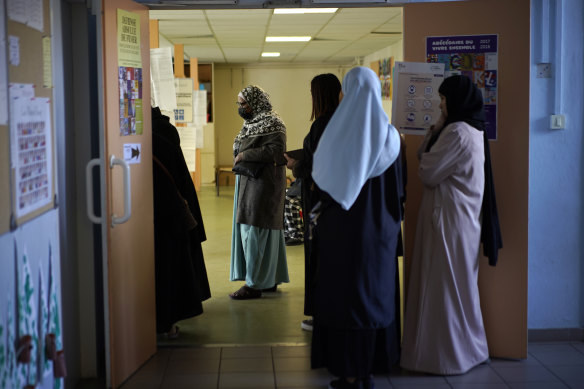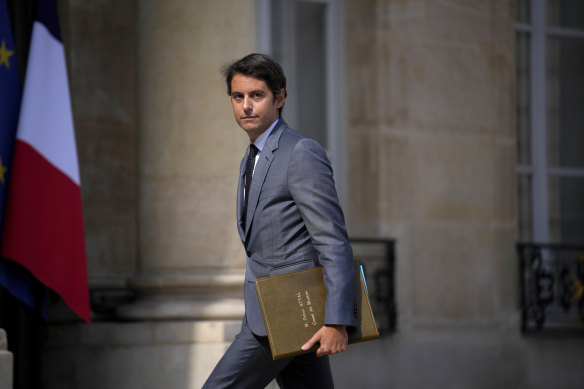Save articles for later
Add articles to your saved list and come back to them any time.
Paris: France will ban children in public schools from wearing the abaya, a loose-fitting, full-length robe worn by some Muslim women, the government said this week. It said the measure was necessary to stem a growing number of disputes in its secular school system.
But critics called the ban a discriminatory policing of teenagers’ clothing, fuelling yet another debate in France over the way Muslim women dress, which has become a recurring flashpoint in the country’s relations with its Muslim minority.
France’s education minister announced that long robes in classrooms would be banned starting with the new school year, saying that secularism in the nation’s schools is being “tested” via the garments, worn mainly by Muslims. Credit: AP
Since 2004, middle and high school students in France have been barred from wearing “ostentatious” symbols that have a clear religious meaning, such as a Catholic cross, a Jewish skullcap or a Muslim headscarf. Since 2011, it has also been illegal to wear a face-covering veil in public in France. French people broadly agree with those rules.
The abaya, however — a long dress that covers the legs and arms, but not the hands, feet or head — falls into a grey area. While it is popular in the Persian Gulf and in some Arab countries, it does not have a clear religious significance.
In France, it is mostly worn by Muslim women who want to follow the Koran’s teachings on modesty. Headmasters had voiced concern over the past year that they needed clear instructions from the government on how to deal with a small but growing number of students coming to class wearing abayas.
This week, the government responded.
“When you enter a classroom, you should not be able to distinguish or identify the students’ religion by looking at them.”
“The abaya has no place in schools,” Gabriel Attal, the education minister, said.
Attal said attacks on the principle of laïcité — France’s version of secularism, which guarantees freedom of conscience but also the neutrality of the state and of some public spaces — had “increased considerably” in French schools.
“When you enter a classroom, you should not be able to distinguish or identify the students’ religion by looking at them,” Attal told the TF1 television channel Sunday.
Laïcité applies to numerous public institutions — public hospital employees, for instance, cannot wear religious clothing — and there is strong cultural aversion to public expressions of faith.
French Education Minister Gabriel Attal.Credit: AP
But schools have historically been the focal point of debates around the issue.
Laïcité came out of the enlightenment philosophy of the 18th century but was also the result of a centuries long battle to reject the dominance of the Roman Catholic Church, especially in schools, which are now widely seen as neutral spaces that forge citizenship and where students can be shielded from religious influences.
“Schools are still an emblematic battlefield,” said Anne-Laure Zwilling, an anthropologist specialising in religion at the CNRS, France’s national public research organisation. “Tensions around laïcité are stronger there.”
France was recently scarred by the killing of Samuel Paty, a teacher who showed caricatures of the Prophet Muhammad in class to illustrate free speech, which led to his beheading in 2020 by an Islamic fanatic.
But a nationwide abaya ban was like “using a bulldozer to crush a fly,” Zwilling said, because it brought disproportionate attention to a complex issue affecting few students.
“The same behaviour can have a totally different meaning depending on the person and on the context,” she said.
Official statistics show the number of incidents related to laïcité reported by school officials has increased, to between 200 to 900 per month over the past year, among a middle and high school student population of nearly 6 million.
Unions representing school administration officials welcomed the ban, arguing the matter shouldn’t have been left to the varying interpretations of headmasters scattered across roughly 10,000 middle and high schools. Teacher unions were more circumspect.
The French Council of the Muslim Faith said that the abaya was not religious in its nature but an ill-defined garment tied to Arab culture.Credit: AP
Sophie Vénétitay, head of one of the main teacher unions, called the ban a “political manoeuvre” by President Emmanuel Macron to curry favour with the right. But, she added, abayas were a real issue that should neither be “overestimated nor underestimated.”
“There would be nothing worse than for those pupils, through provocation, misunderstanding or frustration, to turn away from state schools and go to denominational or private schools,” Vénétitay said at a news conference.
The French Council of the Muslim Faith, an umbrella group of Muslim organisations, said that the abaya was not religious in its nature but an ill-defined garment tied to Arab culture. The government shouldn’t decide what is religious or not, it said.
“Unless all long dresses are banned altogether in schools, for students and teachers, regardless of their faith, it will be impossible to apply a measure specifically targeting the abaya without falling into the trap of discrimination and arbitrariness,” the council said in a statement.
Opposition parties on the right praised the ban, but the left was divided.
“How far will the clothing police go?” said Clémentine Autain, a member of parliament for the leftist France Unbowed party, saying the ban exemplified an “obsessive rejection of Muslims.”
But Jérôme Guedj, a Socialist lawmaker, said that if abayas were worn as an ostentatious religious symbol, they clearly violated the law. “It is not a clothing police but a policing of proselytising in school,” he said.
In November, Attal’s predecessor, Pap Ndiaye, said headmasters could ban clothing even if it did not have any inherent religious significance, including long skirts or bandannas, if officials believed that they were worn “to ostensibly express a religious belonging.”
But Ndiaye — an academic of Senegalese and French descent who was replaced after months of vitriolic criticism from the right and far right – had refused to issue a nationwide ban, arguing that he did not want to “publish endless catalogues specifying dress lengths” that could be circumvented or challenged in court.
Ismail Ferhat, a professor at the University of Paris-Nanterre who has studied laïcité in schools, said students often wore abayas against their parents’ will and noted that factors such as social media fads or the teenage desire to challenge school authority also played a role.
But France has grown more secular over the past few decades, Ferhat said, and what might have been brushed off in the past was now being flagged as serious.
“The line between religiously acceptable and unacceptable has changed,” he said. “And the educational establishment is probably tougher on the issue than before.”
This article originally appeared in The New York Times.
Most Viewed in World
From our partners
Source: Read Full Article








